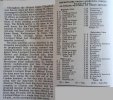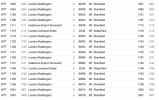Under several different assorted threads the subject of 24 TPH comes up again and again - often directly with Thameslink core or referring to TL core w.r.t. other routes, and or ding this into or from terminal station.
For you entertainment, attached is a photo from part of a page of 01/1961 Trains Illustrated that shows TWO parallel flows of 24 TPH - and more - from Liverpool Street evening peak. This article is a little ahead of the actual situation as the full electric services had not yet started.
Both the Electric and Suburban have 24 TPH, the Mains 21 TPH.
Admittedly this is outbound departing trains evening high peak, and I don't have the gen for inbound morning high peak, but it does show what could be done with clockwork manually controlled signalling and manually driven trains following G YY Y R lights SIXTY PLUS YEARS AGO.
Someone with some time to spare might like to post the current 17:00-18:00 evening peak - but things are obviously different these days as Eliz line has removed that entire service group from the LST Electric lines.
Image from TI duly acknowledged.
For you entertainment, attached is a photo from part of a page of 01/1961 Trains Illustrated that shows TWO parallel flows of 24 TPH - and more - from Liverpool Street evening peak. This article is a little ahead of the actual situation as the full electric services had not yet started.
Both the Electric and Suburban have 24 TPH, the Mains 21 TPH.
Admittedly this is outbound departing trains evening high peak, and I don't have the gen for inbound morning high peak, but it does show what could be done with clockwork manually controlled signalling and manually driven trains following G YY Y R lights SIXTY PLUS YEARS AGO.
Someone with some time to spare might like to post the current 17:00-18:00 evening peak - but things are obviously different these days as Eliz line has removed that entire service group from the LST Electric lines.
Image from TI duly acknowledged.
Attachments
Last edited:



